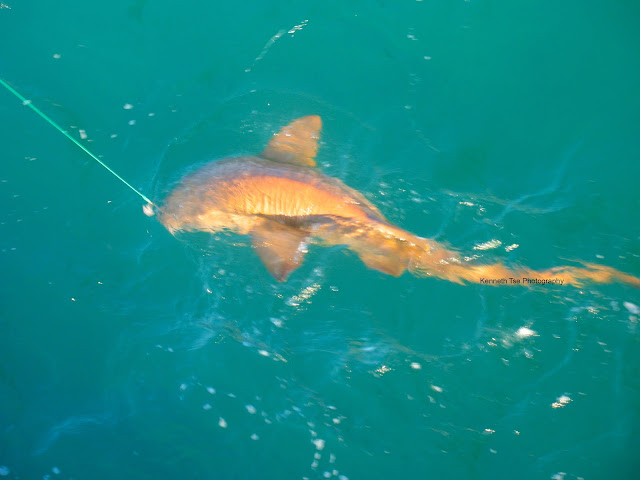Michael and I were getting really tired of our daily routine - taking things out of the trunk and returning things into the trunk just to get at some fishing gear. But we needed the gear...and we had a about 50lbs of gear each! Luckily we had carts to help us pull the gear 2000 feet to the end of the bridge.
After tossing out three rods with shark bait, we settled down into sabiki fishing. A number of cool fish came along if you can get around the constant nuisance of Slippery Dick, Puddingwife Wrasse and Bandtail Puffer. Michael hooked into a decent Yellow Jack on the sabiki. Since we haven't had breakfast yet, we decided to sashimi the fish for breakfast.
We chopped up a number of the frozen herring into the chum bag and soon a school of Threadfin Herring and Leatherjacket swarmed the area.
The chum bag also attracted some interesting fish, including the very colourful but strange looking Scrawled Filefish, the one species I really wanted to add on this trip!
Scribbled Leatherjacket Filefish aka Scrawled Filefish (Aluterus scriptus) - Species #367
While everyone seems to find Yellow Sea Chub, which would be a new lifer for me, I caught a Bermuda Sea Chub :( At least with this one I had counted the fin ray to confirm it was a Bermuda Sea Chub. On my first encounter with this species in Belize I had failed to count the fin rays which made the catch, at the time, not exactly confirmed.
Bermuda Sea Chub (Kyphosus sectatrix)
Ben caught quite a few cool parrotfish including Redtail Parrotfish, Blue Parrotfish, Striped Parrotfish and Redband Parrotfish. Luckily, I wrangled one of these parrotfish too!
Initial phase Redband Parrotfish (Sparisoma aurofrenatum) - Species #368
Species fishing is pretty exciting in the Keys since you can easily catch over 15 species using the sabiki. In fact, Ben ended the day with 16 lifers!
Late in the afternoon, Michael had a good run on the big rod which turned out to be his first Southern Stingray. At 5:30pm, he had another run on the big rod which got us really excited when we saw a shark shape at colour. It was a 6-foot Nurse Shark!
We tried to rope the shark from the bridge but the loop of the rope closed prematurely on the leader and was tangled. We debated walking the shark back to shore but with the tangled rope it was a dangerous task if the shark decided to run, and hazardous to the shark if the main line snaps leaving the shark with a 400lb leader tethered to a thick rope. At the end, we pulled hard enough that the hook pulled out and the shark was released unharmed.
This Nurse Shark elevated our spirit and we were ever more determined to fish harder for sharks. Here's a look at the end of the bridge with rods deployed waiting for the right kind.
We were treated to a beautiful sunset while we waited.
Just before dark, I added one last lifer of the day. It was a Threespot Damselfish. Damselfish are difficult to identify since there are a few very similar looking species. Threespot Damselfish and Cocoa Damselfish both have a small black saddle at the caudal peduncle. However, Threespot Damselfish has a black spot at the axil of the pectoral fin while the Cocoa Damselfish does not. Cocoa Damselfish also has yellow on top of the eye.
Threespot Damselfish (Stegastes planifrons) - Species #369
Miciah needed to grab some dinner and returned with burgers for all of us. Thanks Miciah!
As night fell, we settled into our routine - catch a live grunt, bridle it on the hook, send it out, wait a while, then check the bait. We caught lots of grunts so I filleted some and Ruoxi fried them up with old bay seasoning. They turned out absolutely fantastic!
After dinner, Ben, Ruoxi and Michael decided to check out the rocky areas near shore for eels and other night species. Miciah decided to head to bed early. I kept faith with the shark rods. As the gang left, I joked that "Now my rod is going to go off with a big shark and there will be no one around to help..."









No comments:
Post a Comment